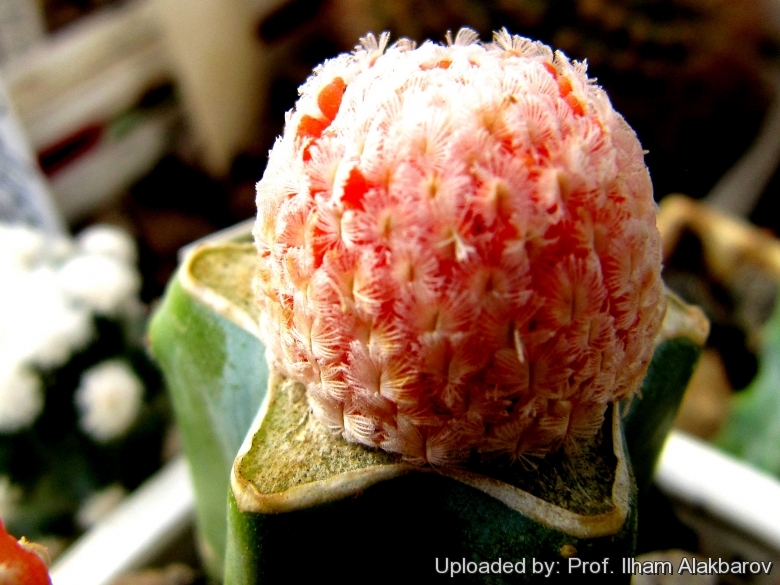Accepted Scientific Name: Mammillaria sanchez-mejoradae Rodr.González
Cact. Suc. Mex. 37(3): 55 (1992)

Mammillaria sanchez-mejoradae f. rubra Photo by: Prof. Ilham Alakbarov
Origin and Habitat: Garden origin (Nursery produced cultivar)
Synonyms:
See all synonyms of Mammillaria sanchez-mejoradae
Description: Mammillaria sanchez-mejoradaeSN|26145]]SN|10779]] is a very slow growing miniature cactus with tiny feathery combed spines.
Forma rubra (red form): The red schizochromic form (Mammillaria sanchez-mejoradae f. rubraSN|10779]]SN|26145]]) has bright orange-red stems due to the absence (or reduced production) of chlorophyll pigments: every other pigment is present at normal levels, the dominant green colouration is lost, but will still more than likely have normal other pigments that give the yellow overall appearance of the stem. This form with red stems is very attractive and highly prized. This schizochromic form is almost always seen grafted on stronger columnar species, and cannot can be grown on its own roots. However some clones have enough chlorophyll in their tissues and can be grown on they own roots too, but very slow growing.
Habit: Usually solitary, (or clumps forming over time)
Stem: Flattened-globose or globose, bright green to 3 cm high, 1-3 cm in diameter.
Tubercles: Conical, without latex, axils naked.
Central spines: None.
Radial soines: 30 to 40 hairlike (or plumose) pectinate, rigid, white, flattened against the tubercles, 1,5-2 mm long (rarely up to 3 mm) long.
Flowers: Campanulate,up to 16 mm long and 20 mm in across variable from white to pink-rose.
Fruits: Club shaped to globose, completely embedded in the plant (cryptocarpic), red, 3-8 mm in diameter.
Seeds: Black.
Subspecies, varieties, forms and cultivars of plants belonging to the Mammillaria sanchez-mejoradae group
Bibliography: Major references and further lectures
1) Pilbeam J., “The Cactus file, Mammillaria” 6: 120, Cirio Pub. Services, 01/Dec/1999
2) James Cullen, Sabina G. Knees, H. Suzanne Cubey "The European Garden Flora Flowering Plants: A Manual for the Identification of Plants Cultivated in Europe, Both Out-of-Doors and Under Glass" Cambridge University Press, 11/Aug/2011
3) David R Hunt; Nigel P Taylor; Graham Charles; International Cactaceae Systematics Group. "The New Cactus Lexicon" dh books, 2006
4) Edward Anderson “The Cactus family” Timber Press, Incorporated, 2001
5) Fitz Maurice, W.A. & Fitz Maurice, B 2013. Mammillaria sanchez-mejoradae In: IUCN 2013. "IUCN Red List of Threatened Species." Version 2013.1. <www.iucnredlist.org>. Downloaded on 22 July 2013
Cultivation and Propagation: Variegated and albinos cacti are regarded as choice and difficult in cultivation, but despite that many of them are relatively easy to grow. But be aware that they cannot tolerate prolonged exposure to direct sun light (especially during the hottest summer days), so grow them in half-shade or under filtered sun. The albinos are always seen as grafted plants as they can survive only if grafted on a strong green base.
Use mineral well-permeable substratum with little organic matter (peat, humus). Water sparingly from March till October and keep perfectly dry in winter at temperatures from 5 to 15 degrees centigrade. (In general these plants are more tender and cannot endure freezing temperatures ) In the rest period no high atmospheric humidity!!
Propagation: Usually by seed. Plants are often grafted onto column-shaped cacti.










